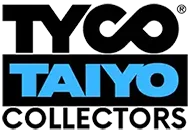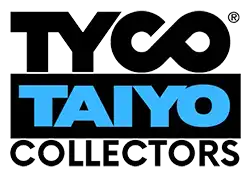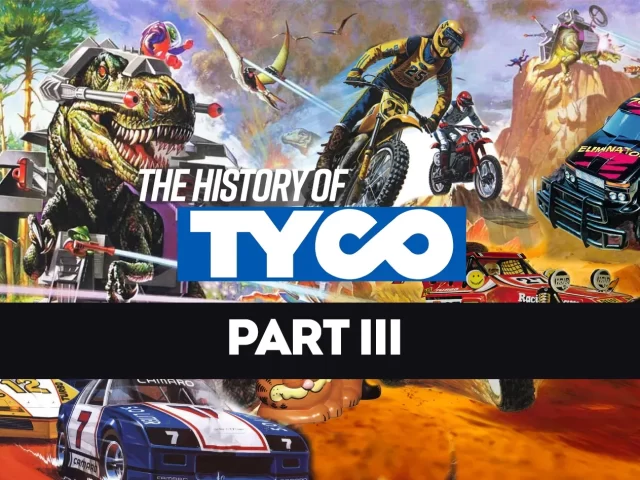In this chapter we cover the Golden Age of Tyco RC, the late 80s to 90s toys we all loved.
Part 1: Early Tyco 1926-1981
Part 2: Tyco vs Lego 1982-1985
Part 3: The Golden Age 1982-1992 (You are here)
Part 4: The Final Days of Tyco (Coming soon)
1986
For anyone attending Toy Fairs in early 1986, it may have seemed like this was going to be another dud year for Tyco, especially with the videogame wars heating up again, all toy makers were under threat.
But midway through something major would happen, and Tyco's destiny would be set in stone for the next decade.

What happened to Tyco RC and every other toy company in 1986?
Nintendo.
Like all major toy industry players in 1986, the huge worry for Tyco at the time was video games. While it had seemed like it was over before it began following the video game depression of 1983-1985, Nintendo would resurrect the video game industry from the grave by bursting onto the market with their trojan horse.
R.O.B.
Nintendo's Robotic Operating Buddy, or R.O.B., was a strategically ingenious product launched in 1985 by Nintendo of America.
Packaged with the Nintendo Entertainment System (NES), R.O.B. was designed to rekindle consumer interest in the video game market, following the industry crash in 1983.
Presented as a high-tech toy rather than a gaming accessory, they managed to circumvent the negativity associated with video games, allowing their console to enter living rooms across America and the world.

Just when they thought they were safe, traditional toy makers were once again back on the chopping block.
This was the environment that Tyco found itself in, having just released their Lego cloned 'Super Blocks' a couple of years prior with hopes it would become their next big seller (and it did - for a while), they were suddenly dealt a hammer blow by an incredibly successful video game system that had captured the entire market and threatened to end 'normal' kids playtime as we knew it.
And that really was the problem - Kids didn't want to play anymore - they wanted to sit down and watch a TV screen.
A brand new killer product was needed, and fast...
Enter the Australian
Around the same time in Australia, a small company named GTI (George Tauber Industries) were selling dolls, action figures, and simple remote-controlled vehicles developed by the Japanese companies Taiyo, Nikko, and Yarezawa. These were relatively slow, realistic looking RC cars that ran best on a flat surface indoors.
They were selling OK in Australia, but a key figure inside GTI named Steven Glatt had an idea for a better product. He'd seen what the likes of Tamiya were releasing as Hobby-Grade models, such as The Grasshopper, The Hornet, and The Frog, and wondered if it would be possible to create toy-grade RC cars with similar dynamic suspension, a more powerful motor, and exciting performance.
In May 1985 they traveled to Japan in search of a manufacturer to pitch the product details to. George Tauber already had contacts at Taiyo Japan, Nikko, and Yarezawa, and it was Taiyo who was most interested in the idea of a new dynamic range of RC cars. There are conflicting reports of whether the original Jet Hopper (Turbo Hopper) concept was a Taiyo original, whether it fully came from the mind of Steven Glatt, or whether it was a combination of ideas between the two.


Somewhere along the way while Taiyo was manufacturing the model, it came to the attention of Tyco Industries in the USA who had been selling a few minor Taiyo products.
Tyco was skeptical of the bringing on a new range of RC cars at first - after all, what they knew of these products was only the slow, cumbersome, and often ugly toys of the late 70s and early 80s. So they decided to wait and see what would happen in the Australian market, as was standard practice at the time. With Australia essentially a much smaller version of the American market with similar tastes and economy, it's often used as a test bed for new products and TV shows before a full commitment is made for the larger US market.
In 1986 in Australia the Metro/GTI Jet Hopper was released, together with the Taiyo Jet Hopper in Japan. It was a mammoth success, and Tyco immediately committed to a new line of RC cars that would soon dominate the industry.

The Back Pages
Other than the usual assortment of 1980s trains and slot car sets that had been in all Tyco catalogs from the last 3-4 years, the very last 5 pages of the 1986 catalog would contain something much more interesting - five new product lines - the first Tyco RC cars.
But why would a new product release be delegated to the last pages, and not right up front, if not on the cover itself?
It's only my opinion, but I believe all the evidence exists that Tyco and the manufacturer Taiyo were under pressure to get enough units into stores by Christmas, with most stock manufactured so far in 1986 already allocated to Australia's Metro/GTI and Taiyo Japan itself where sales were going wild. As such, there just wasn't enough confidence that they'd get units into stores by Christmas '86, never mind throughout the 1986 toy season.
As such, putting it in the last pages and building up hype throughout the year for the potential sneak-peak in late 86, with a full release in 1987 of all the new RC cars would make sense.
Thankfully Tyco did make release in time for Christmas, with the products appearing in a few department store catalogs just in time. Whether they actually received the stock we can't be sure, though we do know for a fact there are Tyco Turbo Hoppers out there with a 1986 date on the box, and with first edition (Taiyo Jet Hopper MK1) features.
And so, the first Tyco R/C cars ever to be released were:
Tyco Turbo Hopper
Tyco would have limited quantity for 1986, with barely enough to stock a few major department stores towards the end of the year. According to promotional shots, what released was essentially the Taiyo Jet Hopper MK1 series with fat front tires, and 'Turbo Hopper' cut out of the front bumper.
Tyco Turbo Stocker
These appear to be the only cars in the initial release which were highly customized for Tyco's American consumers, stylized as actual licensed Stock Cars / Stockers. Without taking a closer look, I'd suggest the chassis is likely one of Taiyo's existing models, with the body, paint, and decal design unique.

Tyco Tiger Tank and Tyco Battle Wagon
Most Tyco/Taiyo enthusiasts are familiar with the Tiger Tank, particularly the original Taiyo Japan version which looks the same but has a working BB gun built into the turret, with the hatch opening for ammo. The Tyco version replaces this with electronic sound effects, safer for the litigation-happy 80s market.
Even I was unaware of the existence of the 'Battle Wagon', an unusual 6 wheeled vehicle which was smaller and likely aimed at more budget conscious customers.

Super 4x4 Off-Roader and 4x4 Ranger with Power Winch
One of the most common and popular radio controlled cars ever produced, the Super 4x4 and its variants were sold by Taiyo, Tyco, Radio Shack, Tomy, and many others right up until the 90s. While fairly slow and noisy with a crunchy gearbox due to the early 80s technology, the built-in power winch and huge air-filled rubber tires are what makes it a winner.
Marketed as the Taiyo Toyota Hilux 4WD in Japan and through western department stores, we suspect many will unlock a very old nostalgic memory when seeing these classic RC cars once again, even if the name isn't familiar.
1987
The front cover of the 1987 Tyco Catalog says it all. After 3 years of stagnation, Tyco R/C finally had its mojo back!
The first 13 pages alone were dedicated to RC cars - they had the stock, they knew it would sell, and they went all out.
Known to be part of this first complete fully resourced release were:
- 1987 Tyco 4WD Super Turbo Hopper
- 1987 Tyco Super Turbo F-1
- 1987 Tyco Fast Attack Vehicle / E.A.V Hopper
- 1987 Tyco Mini Hopper
- 1987 Tyco Indy Turbo - Dominos and Kraco
- 1986/1987 Turbo Stockers - 7-Eleven / Motorcraft

The two most interesting products from this release were the 4 Wheel Drive Super Turbo Hopper and the Super Turbo F-1.


Both carried such a massive jump in sophistication in terms of the chassis design, motor, drive system, and suspension, particularly the Super Turbo Hopper, that it's incredible to think they were delivered only months after the Turbo Hopper which had set the new benchmark.
The 4 Wheel Drive Super Turbo Hopper had dual motors running a single axle, was obviously 4WD,9.6V Turbo with improved suspension and was much larger than the smaller Jet Hopper. It was one of the best RC cars they ever made, and continues to be one of the best "toy grade" R/C until this day.
While we don't have an article on the Tyco Super Turbo F-1 (as of writing), we do have details on the original Taiyo Super Fight F-1 which was the same. This model now appears to have been a first iteration of what would ultimately become the chassis used for the coming Taiyo/Tyco Lamborghini Countach Twin Turbo, arguably one of the best on-road 'toy' RC cars ever released.
Note: There is no available copy of the '87 catalog online, so I've hunted down a real copy and am waiting on it to arrive. The article will be updated once I have more information.
Super Blocks Goes to War
Tyco was not done with Lego yet - and hit them where they couldn't fight back. Since it's inception, Lego has refused to make any toy that represents war, or modern fighting vehicles such as tanks, jet fighters, even aircraft carriers, etc. It's a moral choice, and one that I deeply respect. But of course this is the 80s, and everything is up for grabs, so what did Tyco do?
They launched the Tyco Super Blocks Adventure Military Series! And the advertisement makes these look pretty cool, I'll give them that.
The Tyco Bandit was a slot car first!
If you've ever wondered why the 1990 Tyco Baja Bandit or 1992 Tyco Bandit looks a little different to its drawing on the box, then this is why.
As part of the 1987 toy season, Tyco would launch Racin' Bandits and Racin' Hoppers Electric Racing. The Bandit concept was originally drawn by Ken Smith, an incredible artist who did most of Tyco's slot car sets and radio control car artistry, and no doubt others.
It would later be used as the concept behind the 1990 Tyco Baja Bandit, and the 1992 Tyco Bandit, however few would have guessed that the slot cars came first before the RC cars, a full 3 years before the Baja Bandit, and 5 years before the Bandit as part of a slot car set!
Also featuring were slot cars modelled after the 1986 Turbo Hopper and 1988 Aero Turbo Hopper. All the evidence we have so far is that the Aero Turbo Hopper R/C was released a year later, making the slot car the first time the Aero Hopper was released also!
There are so many other launches in the 1987 catalog.
Tyco Tuffies were large plush dogs that would be a child's "Fearless Friend" - helping them feel safe, and fall asleep at night. Personally I love this idea.
Moving on, did you ever wonder why the 1986 Ghostbusters cartoon was called "The Real Ghostbusters"? In the same year, another cartoon TV series was aired called Filmation's Ghostbusters, based on a live action French TV show "The Ghost Busters" from the 70s.
As you can imagine, having two cartoons called Ghostbusters would cause all kinds of confusion, especially with parents who weren't paying attention to the latest trends.
And so, in the 1987 Tyco would release Filmation's Ghostbusters Ghost Command, along with various action figures and vehicles, totally not taking advantage of it all!


While there are many products that Tyco would take liberal amounts of inspiration from, Lego was the most unapologetic. Yet there was another...
In 1987 Tyco would launch their latest major copy-brand, Super Dough!
The Flower Makin' Basket was one of the initial products which had scented dough that would be pushed through various 'flower pot' shapes in the basket, creating beautiful scented candles. Such a great idea!
As well as Squeeezers which had you pump dough through holes in one of three evil looking heads, resulting in gross worm-like stuff stringing out from their faces.
There are dozens of comments on YouTube from women who owned the Flower Makin' Basket who were nostalgic and bought one for their own daughter, and boys equally admitting they saw the ads and kind of wanted to have a go too! I'm sure both boys and girls would have enjoyed both toys - I know I would have!




1988
The Golden Age of Tyco would not just continue but grow even stronger in 1988 with multiple excellent new releases that we'll cover here.
Ahead of the radio control toys this year was DinoRiders, taking the first 13 pages as the RC cars had the year before.
Followed by a full 21 pages of new radio control toys with some of the best RC cars that Tyco had ever released. This was an incredible time to be alive as a kid who was lucky enough to receive presents from Santa, and for his/her birthday.
The only other new products released were two cooking toys aimed to capture the market from Hasbro's re-released Easy Bake Oven, called Real Cookin' Tasty Bake, Duncan Hines Play Baking, and ColorMagic Play Food.
The rest of the catalog contained Tyco's usual staples:
- New Super Block and Pre-School Super Block sets
- Filmation Ghostbusters, Stomper, Speedsters, and of course slot cars, and electric trains.
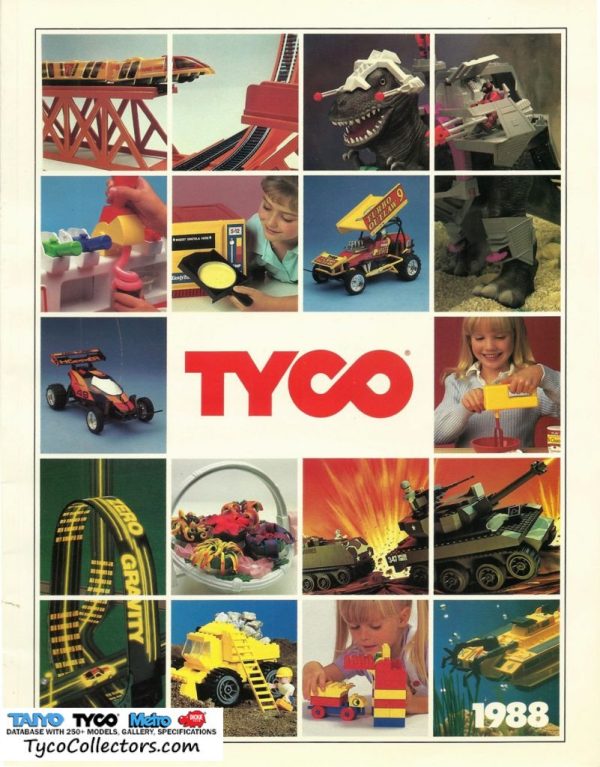
Tyco's greatest ever toy concept?
Dino Riders. Can you think of a more stupendously perfect concept for a kids toy?
The concept was a brilliant combination of dinosaurs, action figures, and space - some of the most popular cultural themes of the 1980s.
Created by a team of writers and designers at Tyco, including Paul Kirchner, Dan Fiorella, and Gerry Conway, among many others, particularly in the actual final designs of the action figures themselves. After months of development, the Dino Riders toy line was released in the fall of 1988, along with an animated TV series.
The toys are impressive even today. Action figures riding on top of realistic looking dinosaurs (or at least, an interpretation of how we understood dinosaurs in the 80s). They held futuristic weapons, and battled it out with others who also rode atop the massive beats.
In designing the figures, Tyco faced a number of challenges, such as making sure that the sometimes intricate details would stand up to rough action figure play, and would be the correct scale and shape to fit the action figures on top.
Their hard work paid off, and Dino Riders was a massive success.
But it wasn't just the toys and TV advertisements that made them successful. Due to the loosening of children's TV advertising years earlier by the Regan Administration, Tyco were able to develop a 30 minute per episode animated TV series where they introduced a complex story line involving time travel and a battle for the fate of the universe! The Dino Riders (good guys) would fight against the alien Rulons (bad guys) across history, providing a storyline with rich rodder for an entertaining and engaging children's TV show.
Possibly the most memorable of the toys was the 1/24 scale Rulons Tyrannosaurus-Rex, though virtually all of the toys in the range were impressive. Others included the Dino-Riders Torosaurus with lasers, there were Pterodactyls with heat seeking missiles... I mean, come on, why isn't this still a thing today! Glorious!


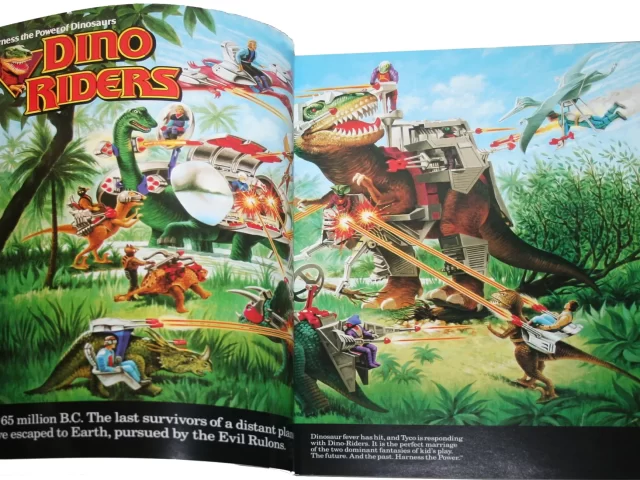

As if that wasn't epic enough for 1988, up next was 20+ pages of the best RC cars that Tyco R/C had produced so far in their history, including 4 of my Top 10 All-Time-Greatest!
Leading with the Tyco Turbo Outlaw, still revered today as one of Tyco R/C's best.
Followed up with perhaps the best of them all, the Twin Turbo Lamborghini Countach with a near hobby grade chassis, dual motors, front wishbone suspension, and incredible Lamborgini Countach looks... it's 80s cool all over.
Collectors who pay attention will immediately notice a CHROME Twin Turbo Lamborghini Countach!


in the 1988 Tyco Catalog
Sadly this was never released - to our knowledge, perhaps because chrome is notoriously difficult to paint. Smaller parts being dipped is fine, however whole entire bodies would be asking for a very high reject count, and thus added costs. Note the Twin Turbo Hoppers are more of a matte silver, but this is clearly a reflective chrome.
Whatever the case, it looks WILD and we hope it inspires those highly capable custom builders to create one!
Equally sophisticated was the Twin Turbo Hopper - as well engineered as the Lamborghini, but made for 2WD dirt tracks / off-road use. At a relatively huge 1/12 scale, it must be the biggest model Tyco had produced until then.
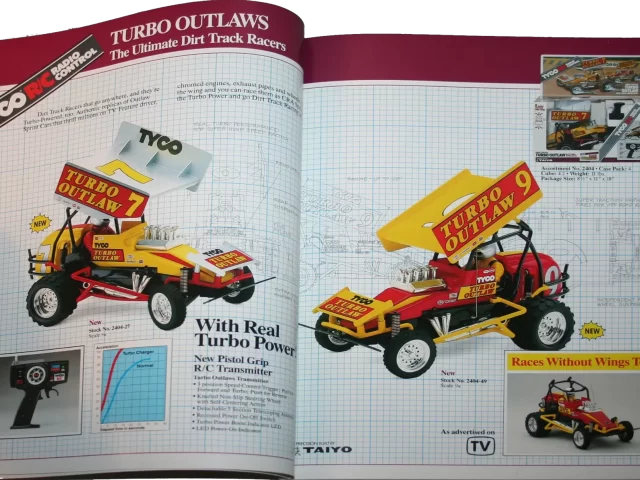

This was followed by the Tyco Bandit's predecessor, and my personal #1 favorite..
The 4WD Turbo Racing Pickup. The most highly engineered, near hobby-grade R/C that Taiyo or Tyco R/C would ever produce, if there's only one you check out from this list, make it this one!!!
Other releases in 1988 include:
- 4WD Super Turbo Hopper (from 1987 catalog)
- Aero Turbo Hopper
- Turbo Hopper MK2
- Toyota MR2 and Nissan 300ZX
- Porsche 959 and BMW M3
- Chevy Pickup and 4WD Monster Jeep
- Indy Turbo Miller and Pennzoil
- Mini Hopper 2 and Aero Mini Hopper 2
- Citigo Turbo Stocker* and Motorcraft Turbo Hopper
- Turbo Porsche 962
- 4WD Turbo 4's and Super 4x4 Jeeps
*I'm not sure if this was ever released, and suspect the CitiGo decals may have been replaced with the 7-Eleven livery by the time of production.
1989
The Golden Age continues in 1989 with Dino Riders continuing to be the leading product.
And who can blame them - checkout the Dino Riders Brontosaurus with Full Battle Accessories!
The much loved/hated Tyco Typhoon Hovercraft was also released this year, see its page for more detail.
This was also the year that 9.6v Turbo Battery Packs were introduced, along with re-releases of previous cars upgraded to this format. It should be noted that 8xAA Batteries is also 9.6V, and so there's no performance difference when using the packs, in fact you can get more performing using AA batteries as you can throw in Alkalines (12V!).
Note: I currently do not have a copy of the 1989 catalog to provide more detail, but if you do, or have photos, please contact us!
This Article is a Work In Progress....
Bookmark this page (Ctrl+D) and check back later!
1991
Writing in progress...

Sources:
- https://www.pgpedia.com/t/tyco-toys
- https://hotraincollector.com/tyco-trains-history/
- https://www.ancestry.com/1940-census/usa/New-Jersey/Norman-Tyler_4pvyvc
- https://tycotrain.tripod.com/tycotrains/id64.html
- http://www.tcawestern.org/tyco.htm
- http://www.fundinguniverse.com/company-histories/tyco-toys-inc-history
- https://www.ancestry.com/imageviewer/collections/2442/images/m-t0627-02343-01000?ssrc=&backlabel=Return&pId=134713790
- https://www.findagrave.com/memorial/154527604/john-n-tyler
- https://www.referenceforbusiness.com/history2/74/Tyco-Toys-Inc.html
- https://www.washingtonpost.com/archive/business/1987/09/01/lego-tyco-each-declare-victory-in-battle-of-the-bricks/0d3f7283-37d7-4687-8f3e-ec5cb14d173b/
- https://en.wikipedia.org/wiki/Lego_clone
- https://www.parrygamepreserve.com/features/catalogs/tyco/1988Tyco.php
- https://archive.org/search?query=tyco+catalog
- https://shop.hcslots.com/tyco-440x2-high-performance-parts-c67/
- http://www.riggenho.com/patdennis2.htm
